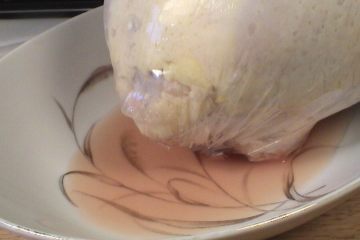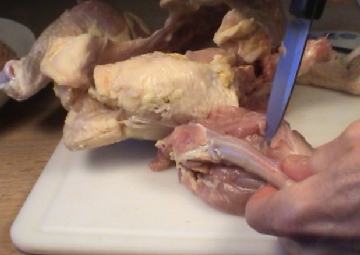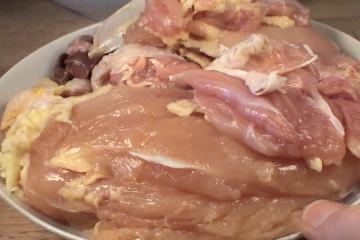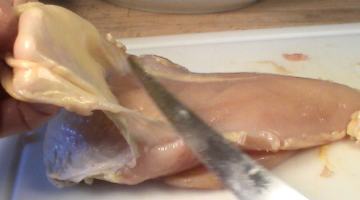1)
Eating virtually all
of a chicken
Are we wasting a lot of valuable
food?
A lot of people are discarding large portions that may be "food".
For example, as I mentioned in another file, we ought to investigate whether
we can extract valuable nutrients from tendons, cartilage, bones, and eggshells.
In such a case, we could grind them up and add them to sausages or burgers.
In the photos below, I show how I use virtually everything in a chicken.
| When I first open the chicken, a lot of juice comes out, but why discard
that juice? I save it in a bowl. I will later grind up some portions of
the chicken, including the kidney, heart, and whatever else is inside that
paper package inside the chicken, and add that ground-up chicken to this
juice. |
|
I begin by cutting the chicken in half. I will cut out some the large
chunks of breast meat rather than grind it. Chicken wings taste so good
when baked, and they have so little meat, that I don't bother trying to
grind them. Rather, I cut off the wings and save them for baking. |
 |
|
|
In this example, I am going to grind up the meat from the chicken legs. |
|
In the photo below, I'm cutting off the cartilage and tendons, and
I will grind them up. |
 |
|
|
The photo below shows all of the meat that I cut off the chicken bones.
I will save the large pieces of breast meat, but I will put the rest of
the meat in the meat grinder. |
|
The photo below shows a close-up of the cartilage, cut in half. I will
put all of that cartilage into the meat grinder, also. Is there something
wrong with eating this? |
 |
|
|
The chicken skin is actually extremely tasty! It can be fried, baked,
or put through the meat grinder. In this example, I am cutting off two
large pieces of skin. Farther down on this page, here,
I show one interesting way of cooking chicken skin. |
|
Although I would normally save the big chunks of white meat, for this
example I am going to chop the white meat into cubes just to show you one
of the options we have when processing chicken. |
 |
|
|
And now I am grinding the meat. I am using a very coarse grind rather
than a fine grind, and I will grind it only once. |
|
The very dark red colored meat is from the liver, kidneys, heart, and
whatever else was in that paper package. |
 |
|
|
Here is a close-up of the finished, ground meat, showing the liver
and kidney and other portions. |
|
And here is a close-up of the meat that has more of the breast and
leg meat. |
 |
|
|
Now that the grinding has been finished, I have:
• a large bowl of ground-up chicken, which is very wet because
I mixed in the juice that came out of the chicken package when I first
opened it.
• two chicken wings
• two large pieces of skin
• a pile of breast meat that I cut into cubes
• two leg bones, a neck bone, and a chicken skeleton
As the photo below shows, I cracked the chicken leg bones in half with
a pair of pliers, and put them into a crockpot with the rest of the skeleton,
and cooked it for a while with a small amount of water on the bottom of
the crockpot. The result was a small amount of a strong flavored soup with
small bits of dark brown bone marrow. I poured that small amount of soup
into a larger bowl of soup that I made from ground chicken (I describe
the "ground chicken soup" farther down, here, in this
article). The dark specks on the chicken meat, in the photo below, are
the bits of bone marrow, and for some reason, the bone marrow gave the
soup a slightly greenish tint.
 |
|
So, now I will show you some meals that you can make from this
ground chicken, and from larger pieces of chicken.
|
|